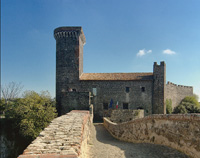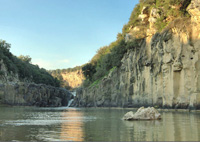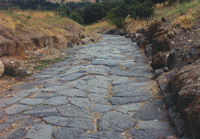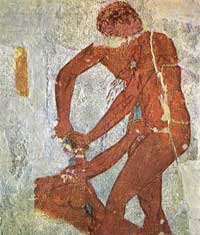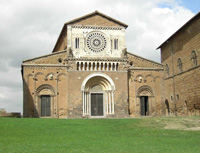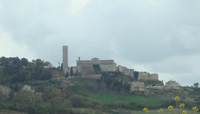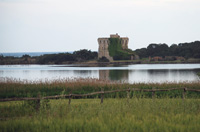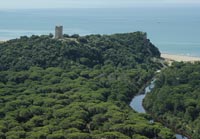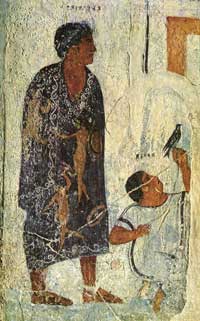Walking in Tuscany | The Naturalistic Archeological Park of Vulci |
The Naturalistic Archeological Park of Vulci is spread over a scarcely inhabited section of the Tuscan-Lazio Maremma, between the villages of Montalto di Castro and Canino. It is crossed by the Fiora river that has excavated the volcanic rock into a deep canyon and then formed Pellicone lake.
|
|||
|
|
|||
Walking in Tuscany | Itinerary in the Naturalistic Archeological Park of Vulci |
|||
The itinerary combines stunning gorge scenery and fascinating archaeological discoveries. A Roman road winds through the ruined temples and market place of Etruscan Vulci. Then on through holm oaks and wild olive trees to the stunning waterfall at Lake Pellicone, look out for kingfisher at the water's edge.
|
|||
The museum also has an extraorinary selection of bronze and ceramic objects such as curious hut-shaped urns, some beautiful samples of bid bucchero ware, mirrors and anatomieal ex voto objects. Canino The hills that surround Canino reach the Riserva Naturale Selva del Lamone and are cultivated with grapes and olive, the famous olive oil extra vergine di oliva, from the Canina olive variety. Castro Walking along via Vulci, you will come to a door in the northern section of the walls. From here, you can access piazza Felice Guglielmi, which is overlooked by the neoclassical facade of Santa Croce. The inside has a single nave, and above the altar, preserved inside a glass case, is an exquisite painting, showing La Madonna della Vittoria.
A nearby World Wildlife Fund Oasis provides refuge for otters and water fowl, and can also be visited, as can Castro, another Etruscan site. |
|||
The municipality of Montalto di Castro contains the frazione Pescia Romana, and is the site of the never-operated Montalto di Castro nuclear power station. Montalto di Castro borders the municipalities Canino, Capalbio, Manciano, Tarquinia and Tuscania. |
|||
| The François Tomb |
||
| The François Tomb is an important painted Etruscan tomb from the Ponte Rotto Necropolis in the Etruscan city of Vulci, in central Italy. It was discovered in 1857 by Alessandro François (it) and Adolphe Noël des Vergers (fr). It dates to the last quarter of the fourth century BC. The tomb seems to belong to the Etruscan family of the Saties (or Seties) and one of its chief occupants is Vel Saties, who appears with his dwarf, Arnza. Its painted frescoes are significant both iconographically and also in terms of their comments on Etruscan history and identity.
|
||
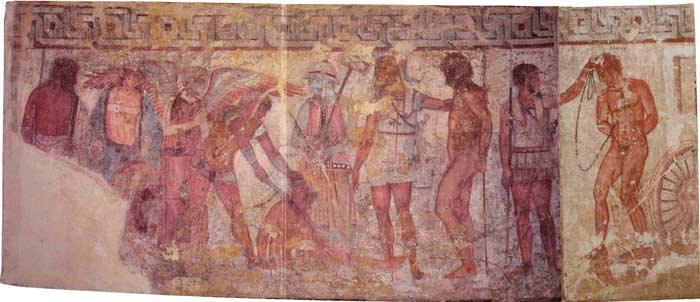 |
||
Achilles' sacrifice of the 12 Trojan prisoners at the funeral of Patroclus. Part of a wall painting in the Francois Tomb, Vulci, 350-330 BC. Museo Torlonia, Rome |
||
| This elaborate underground tomb has an exceptionally long dromos (27 metres), which leads to an enlarged chamber leading to the entrance of the tomb. This leads to a large central hypogeum (atrium) which is roughly T-shaped, A succession of 7 chambers lead off the atrium with the principal tablinium chamber directly in line with the entrance, and three others leading off from either side. An additional three ediculae lead off the dromos. The walls of the atrium are richly decorated with subjects ranging from the Illiad to Etruscan battle scenes. The upper panels show hunting scenes and mythological animals. A square labyrinth meander, painted in 3 dimensional perspective, separates the main panels from the upper mensola, which depicts geometrical patterns. A single element of this meander pattern is repeated in the architectural form of the high vaulted ceiling. Doors have feint pillars and architraves. The murals were detached on the orders of Prince Torlonia shortly after their discovery, and were relocated to the Museo Torlonia. Since 1946, they have been stored at the Villa Albani in Rome as part of the Torlonia collection. The tomb is important because it gives an unique snapshot of Etruscan and Roman history during the early days of Rome. It confirms the later version of history given by the Emperor Claudius in the Lugdunum tablet, in which he describes the Etruscan version of the story of Servius Tullius (Mastarna).[1] °° The François Tomb also contains a fresco depicting Caelius Vibenna (whom the Romans believed the Caelian Hill was named after) and Mastarna (a legendary figure whom the Emperor Claudius identified with Servius Tullius). The Italian foundational myth of fratricide (Romulus and Remus) is reprised in the deadly conflict between Eteocles and Polynices. In Greek mythology, Polynices or Polyneices (Greek: Πολυνείκης, transl. Polyneíkes, "manifold strife") was the son of Oedipus and Jocasta. His wife was Argea. His father, Oedipus, was discovered to have killed his father and married his mother, and was expelled from Thebes, leaving his sons Eteocles and Polynices to rule. Because of a curse put on them by their father, Oedipus, the sons, Polynices and Eteocles, did not share the rule peacefully and died as a result by killing each other in a battle for the control of Thebes. |
||
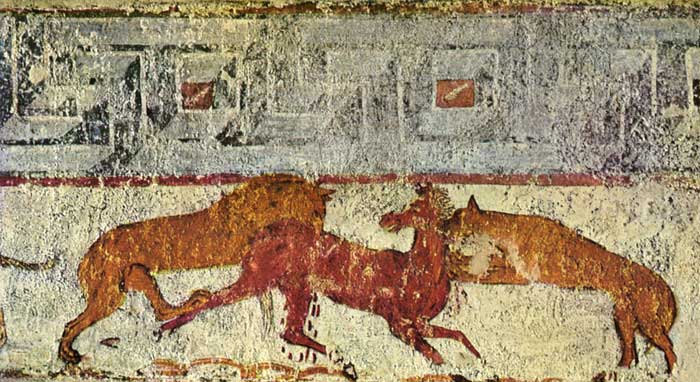 |
||
Detail of frieze with animals. 2nd—1st centuries B.C. From Vulci, François Tomb. Rome, Torlonia Museum. |
||
Hidden secrets in Tuscany Tuscan farmhouses | Podere Santa Pia |
||||
Tarquinia |
Lago di Burano |
|||
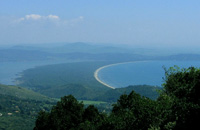 |
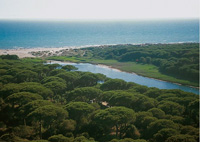 |
|||
Tombola di Feniglia, view from Between Ansedonia and Porto Ercole lies the gorgeous sandy beach stretching from Feniglia for 6 km. You can only reach this part by foot or bicycle as this park is unter nature protection. |
Parco Naturale della Maremma
|
Principina a Mare
|
||
|
||||
| [1] The Francois Tomb, Vulci |www.mysteriousetruscans.com The Francois tomb is so named after its discovery in 1857 by Florentine archaeologist Alessandro Francois and French historian Adolphe Noël des Verges, author of "L'Etrurie et les Etrusques". Des Vergers gives us an exciting account of the discovery of the Francois Tomb. He writes how Francois began his search by the ancient Ponte de Badia, which spanned the River Fiora. After days of fruitless searching through rough thicket, Francois and Des Vergers finally came upon an opening filled with rubble, hidden under moss-coated scree. After careful examination, Francois came to the conclusion that it must lead to a large undergound tomb. After summoning a gang of workmen from Montalto di Castro, work commenced on removing the debris from the tunnel. The long excavation continued, and a 'cippus' or tomb marker was found, with the inscription Ravnthu Seitithi (TLE 303), the name of a woman of the gens Seities. Francois then tells of one evening when the excavation supervisor explained to him that there had been a cave-in,and expressed doubts about being able to proceed. Francois went on to explain, "The next day I had a hole bored through the middle of the debris. Then I lay down full length on the ground and worked my way through the entrance. After I had gone about 3 metres, I was able to lift my head and I lit the torch I had brought with me... Soon I found myself in an underground room carved out of the travertine rock, and about 4-5 metres high." After making his way back to daylight, Francois ordered the opening to be enlarged, and then, together with des Vergers and some workmen, he returned to the dromos. The unforgettable moment of his great discovery came when, wrote des Vergers, "at the last stroke of the pick the stone that closed the entrance to the crypt yielded, and the torchlight shone upon vaults whose darkness and silence had remained undisturbed for more than twenty centuries." Spellbound, the two men lingered, stirred by the magic of this bygone world. Then, as after a little while their eyes became accustomed to the gloom and they began to gaze around the deep underground chamber, there came the second surprise, no less exciting than the first. |
||||
All around, the walls of the tomb were covered with frescoes. They depicted scenes of bloodshed and cruelty, scenes of furiously fighting men and of slaughter. On the left wall from the entrance were (left to right) Ajax (aich) seizing Cassandra (cas'ntra) at the altar after the capture of Troy, Phoenix (Phenuis)- the mentor of Achilles, Nestor King of Pylos, and the fratricidal struggle of Eteocles and Polynices from the seven against Thebes legend. On the entry wall, to the left appeared the execution of the Trojan prisoners, the human sacrifice offered to the soul of the dead Patroclus. Achilles was shown in the act of carrying it out. He had plunged his sword deep into the neck of a youth whose eyes seemed frozen with terror and pain. All these were scenes from Greek legends and the subject matter was nothing new, with the exception of the Etruscan underworld deities Vanth and Charu(n).[1] |
||||
| This article incorporates material from the Wikipedia article François Tomb published under the GNU Free Documentation License. Wikimedia Commons has media related to François Tomb (Vulci). Photo credits: Podere Santa Pia and for François Tomb: Les Grands Siècles De La Peinture : La Peinture Étrusque, © 1985, by Editions d’Art Albert Skira S.A., Genève. First edition © 1952, by Editions d’Art Albert Skira S.A., Genève. |
||||


